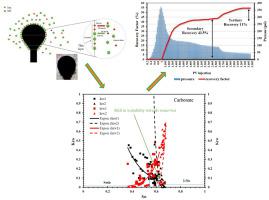Journal of Petroleum Science and Engineering ( IF 5.168 ) Pub Date : 2022-08-12 , DOI: 10.1016/j.petrol.2022.110942 Abbas Khaksar Manshad , Mohammad Javad Nazarahari , Ali Shafiei , Siyamak Moradi

|
Injection of smart water mixed with various oil-water interfacial tension (IFT) reduction agents such as nanoparticles (NPs) into oil reservoirs is a proven enhanced oil recovery (EOR) method. A novel silica-montmorilant-xanthan was used to formulate novel hybrid nano-smart water solutions for EOR. Performance of the hybrid nano-smart water solutions as dispersion media at optimum salinity and NC concentrations was assessed. Stability, IFT, zeta potential, and wettability alteration of the solutions were assessed to find the optimum concentrations. Two groups of single and binary salts were used in the smart waters. Smart waters with individual NaCl, KCl, MgCl2, CaCl2, Na2SO4, MgSO4, CaSO4, and K2SO4 salts at concentrations of 1000, 2000, 4000, and 10,000 ppm in one group. Smart waters with a combination of each of the chlorates with various sulphates with equal ratios (1000/1000, 2000/2000, 4000/4000, and 10,000/10,000 ppm) in distilled water in another group. Smart waters with a combination of each of chlorates with various sulphates with equal ratios in distilled water in another group. Then the effects of the solution of these salts on IFT and contact angle in water-oil-sandstone and water-oil-carbonate systems were investigated. The optimum concentration of K2SO4+MgCl2 for the sandstone sample was determined as 1000/1000 ppm with 1000 ppm of the NC. The optimum concentration of MgSO4 for the carbonate sample obtained was 10,000 ppm with 250 ppm of the NC. The lowest IFT (15.42 mN/m) was obtained for the nanofluid with an NC concentration of 250 ppm. The results suggest that the salt-in effect and nano-film formation are behind the IFT reduction. Contact angle at the same NP concentration decreased from 109° (preferentially oil wet) to 33° (strongly water-wet) in the carbonate sample. For sandstone, the contact angle at the same NC concentration increased from 77° (preferentially water-wet to 117° - preferentially oil wet). Finally, we used the optimum formulas for core flooding to examine the performance of the prepared hybrid nano-smart water solutions. Using these novel hybrid nano-smart waters yields oil recoveries of up to 54% and 60% of the Oil Originally in Place (OOIP) in carbonate and sandstone samples, respectively.
中文翻译:

用于 EOR 的新型混合纳米智能水与可溶性氯化物和硫酸盐以及二氧化硅-蒙莫里兰-黄原胶纳米复合材料:来自 IFT 和接触角测量以及岩心驱替测试的见解
将混合了各种油水界面张力 (IFT) 降低剂(如纳米颗粒 (NPs))的智能水注入油藏是一种行之有效的提高采收率 (EOR) 方法。一种新型二氧化硅-蒙莫里兰-黄原胶用于配制用于 EOR 的新型混合纳米智能水溶液。评估了混合纳米智能水溶液在最佳盐度和 NC 浓度下作为分散介质的性能。对溶液的稳定性、IFT、zeta 电位和润湿性变化进行了评估,以找到最佳浓度。在智能水域中使用了两组单盐和二元盐。具有单独 NaCl、KCl、MgCl 2、CaCl 2、Na 2 SO 4、MgSO 4、CaSO 4的智能水, 和 K 2 SO 4盐在一组中的浓度为 1000、2000、4000 和 10,000 ppm。在另一组蒸馏水中,每种氯酸盐与各种硫酸盐以相等的比例(1000/1000、2000/2000、4000/4000 和 10,000/10,000 ppm)组合而成的智能水。在另一组蒸馏水中以相等比例混合各种氯酸盐和各种硫酸盐的智能水。然后研究了这些盐的溶液对水-油-砂岩和水-油-碳酸盐体系中IFT和接触角的影响。砂岩样品的最佳 K 2 SO 4 +MgCl 2浓度确定为 1000/1000 ppm,NC 为 1000 ppm。MgSO的最佳浓度4获得的碳酸盐样品为 10,000 ppm,NC 为 250 ppm。对于 NC 浓度为 250 ppm 的纳米流体,获得了最低的 IFT (15.42 mN/m)。结果表明,盐入效应和纳米膜形成是 IFT 降低的原因。在碳酸盐样品中,相同 NP 浓度下的接触角从 109°(优先油湿)降低到 33°(强水湿)。对于砂岩,相同 NC 浓度下的接触角从 77°(优先水湿到 117° - 优先油湿)增加。最后,我们使用最佳的岩心驱油公式来检验制备的混合纳米智能水溶液的性能。使用这些新型混合纳米智能水,在碳酸盐和砂岩样品中的石油采收率分别高达原地石油 (OOIP) 的 54% 和 60%。


























 京公网安备 11010802027423号
京公网安备 11010802027423号